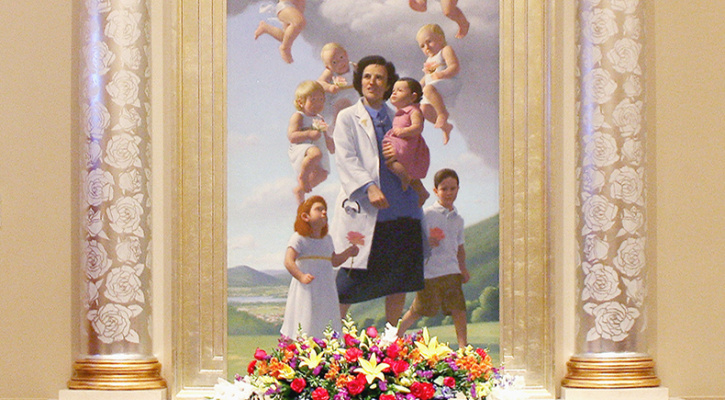The Most Generous Generation in the U.S. is …

The Human Tendency Toward Acquired Deafness
October 2, 2017
VIDEO: Fr. Mark Goring – Little Attachments
October 2, 2017
By Michael F. Haverluck, OneNewsNow.com, October 1, 2017
As the world recovers from multiple national disasters, a new study reveals that age affects giving in Americans.
After conducting a recent survey, the Barna Group and Thrivent Financial discovered that there are significant gaps between generational groups when it comes to generosity, how such charitable acts are practiced and its overall importance among competing priorities in their lives.
What is generosity to Americans?
When asked that they believe an act of generosity is, Americans have very differing opinions.
“’Service’ (32 percent) and ‘emotional/relational support’ (30 percent) are the two most popular responses among American Christians when asked what actions they associate with the concept of ‘giving to others,’” Barna reported. “About one in five says giving money (22 percent), while fewer say ‘hospitality’ (12 percent) or ‘gifts’ (5 percent). Surprisingly, donating money is third on the list, and only one-fifth of adults selects it as their top expression of ‘giving to others.’”
Broken down by age, it was found that generational gaps are very wide when it comes to views on giving.
“Millennials [the youngest generation of adults], for example, are on par with the norm when it comes to service, emotional or relational support and gifts,” the researchers explained. “But the percentages for money (13 percent vs. 22 percent all Christians) and hospitality (21 percent vs. 12 percent) are essentially flipped: Millennials prioritize hospitality far more than money as an expression of generosity. At a different extreme are Elders, who are much more likely than the average to strongly associate service with generosity (52 percent vs. 32 percent) and not at all likely to choose hospitality (less than 1 percent of Elder respondents chose this option).”
How Americans want to give
The ideal way to be generous for some is giving money, while for others, it is serving others.
“Three out of five people who practice generosity by offering emotional or relational support to others generally associate acts of relational support with generosity,” the research group discovered. “Serving or volunteering and offering relational support are the most common expressions of generosity across generations, but percentages vary – likely related in some instances to free time and financial situation.”
The oldest and youngest generations of American adults see giving in different ways.
“Elders, for example – many of whom are retired or no longer working full time – are the age cohort by far most likely to report expressing generosity in service or volunteerism,” Barna found. “And Millennials, who tend to have fewer overall financial resources, are least likely to say they most often express generosity through monetary giving.”
Time or money?
Even though serving others is the preferred form of giving for Americans, giving money is still easier to monitor.
Differences in churchgoing status, expectations for age and marital status showed different trends for giving.
{Y]ounger adults tend to earn less money, to attend church less often (or not at all) and to be unmarried, and 84 percent of Millennials report donating less than $50 during the past year – more than twice the percentage of Elders who say so (37 percent),” the pollsters divulged. “However, even though middle-aged and older adults tend to earn more, to attend church more often and to be married, their self-reported giving is only slightly higher than what one might expect, given these factors.”
Financial goals visited
How much Americans give monetarily and how this comes into play with their expectations was also monitored in the survey.
“[B]etween 2013 and 2016, practicing Christians report giving an average (median) of $1,400 a year to their church – somewhere between 3 and 4 percent of their disposable income (based on the average U.S. net income of $39,424),” Barna pointed out. “This isn’t much. The reason could be that out of 10 possible answers to the question, ‘What would you consider to be the ultimate financial goal in life?’ the option ‘to serve God with my money’ ranks at only number six among Christians. A total of just one in 10 Christians chose that answer.”
Tithing and charitable giving are not viewed as being among the most important acts of worship to God by most Americans.
“Serving God with one’s money is, for most people, not as urgent as other priorities – though Elders are twice as likely as others to say it is, which makes serving God the number-one financial goal among senior Christians,” the Barna report reads. “The percentage of Elders whose goal is ‘to have enough money to give charitably’ is also higher than average (18 percent vs. 11 percent all Christians). ‘Providing for my family’ tops the list among all Christians (22 percent), and Millennials are more likely than the norm to select this option (31 percent). Since many young adults are starting their family (or at least contemplating it), it makes sense that this obligation would be on their minds.”
The younger the more generous?
According to the survey, young American adults are more prone to believe that being generous is a high priority.
“Among the generational groups, Millennials are the most likely to say that generosity is important to them personally,” those conducting the survey found. “Boomers are less apt to say so, and twice as likely as the youngest adults to say generosity is only somewhat or not very important to them (39 percent vs. 20 percent Millennials). Generosity appears to be important to most Christians, but [this does not always align with their practices].”
Self-conscious
The Christian research group then posed the following question to participants, “If your friends knew everything about your finances and giving habits, how would they rate your generosity?” … and here is what they found:
“Millennials are slightly more prone than their older counterparts to say their friends would rate them as very generous, while Elders are least likely to say this,” the data revealed. “Twelve percent of Boomers, meanwhile, say their friends would rate them as not very generous – six times the percentage of Elders who say so. A plurality in each generation says they are somewhat generous.”
And when Christians were asked, “Which is most generous with money, time and hospitality?” regarding the generations in their church congregation, it was found that there is a great degree of generational loyalty among older Christians, while less consistent perceptions were registered by younger adults.
“The older three generations (Gen X, Boomers and Elders) believe that, out of all the age groups in their church, Boomers give money most sacrificially – but among Gen X, only about one-third says so, compared to majorities of both Boomers and Elders,” Barna revealed from the results. “The greater part of Millennials is nearly split on whether Boomers or Gen X are most sacrificial in their giving, but one in five says their own generation sacrifices most when it comes to financial giving. Fewer than one in 20 among the older generations agrees.”
Christians have a distinct mindset when it comes to how they believe different age groups donate their money.
“As with financial giving, most Christians perceive Boomers to be most sacrificial with their time, and the percentage that believes Millennials to be most generous in this regard shrinks in each successively older generation,” the Ventura, California-based research group stated. “Thirty-five percent of Millennials say their age cohort is most sacrificial when it comes to time, compared to one in seven Gen X, one in 10 Boomers and just 3 percent of Elders. When it comes to hospitality, more than three-quarters of Christians over 50 say older adults are strongest in this area; two- thirds of Gen X agree that Boomers and Elders in their church are most hospitable. Millennials, meanwhile, consistent with their definition of generosity, give themselves high marks here.”
Millennials changing the giving landscape
Charitable giving looks much different today to many Americans than it used to, as young Americans look toward convenience through technology more than any other generation.
“Millennials – young people in their 20s and early 30s – are changing the philanthropic landscape,” TheBalance.com reported. “They bring new expectations to charitable giving, and they demand new kinds of information from charitable organizations. New services for charitable giving are popping up to give Millennials the giving experience they want, but many nonprofits and workplace giving programs have not yet caught up.”
Online and social giving are Millennials favorites.
“The biggest disruptor of charitable giving in the past decade has been the growth of online and social ways to give back and the fact that almost everyone has a smartphone in [his or] her pocket,” TheBalance.com’s Bradley Depew noted.
Statistics provided by Blackbaud’s annual Giving Report indicate that the days of writing checks and sealing them in envelopes to drop off at the post office are quickly coming to a close:
- Overall giving grew approximately one percent in 2016
- But, online giving grew 7.9 percent in 2016
- Online donations were 7.2 percent of all fundraising in 2016
- #GivingTuesday online donations were up 20 percent in 2016
- Nearly 17 percent of online donations were made on a mobile device in 2016




